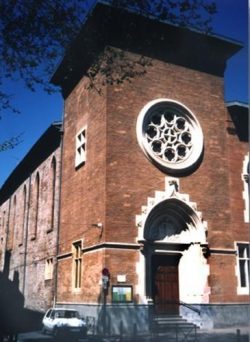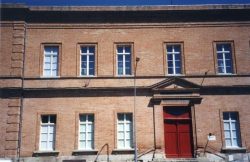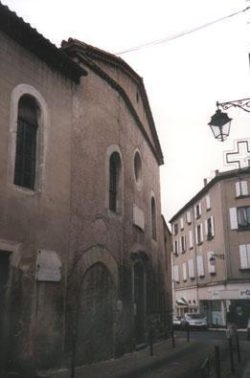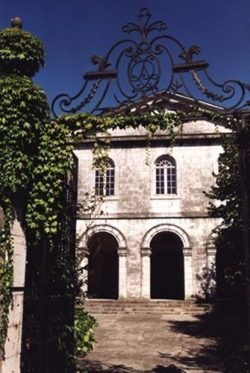Midi-Pyrénées
Salin Temple in Toulouse (Haute-Garonne)
The present Salin Temple was established in the former royal Treasury building, built in 1272 when the Comte de Toulouse joined the Capetians. It was used as such till the Revolution.
In 1792 the buildings and gardens were given to the state and sold as national property. In 1806 Notre-Dame nuns, called the ladies of Salin, bought the convent, the church of Saint-Antoine du Salin and the adjoining treasury building.
In 1904, under the law separating church from state, the religious order was disbanded, and the estate sold in eight lots.
Two Protestant tradesmen bought the treasury building and later sold it to the Protestant congregation. The architect Léon Daurès was asked to renovate the Temple in a neo-gothic style. Listed as a historic monument, Salin Temple still is a Reformed place of worship.
Carmelite Temple in Montauban (Tarn-et-Garonne)
In 1560, the Reformed community in Montauban drove the clergy away, took possession of and looted the churches. The Carmelite Fathers left their convent in 1561 and did not come back before 1635. The Carmelite convent and chapel were then rebuilt.
At the Revolution, the Carmelite chapel was bought by Lauzet, a Protestant tradesman. On 20 January 1793, Jeanbon Saint-André, a member of the National Convention and pastor, managed to have the chapel officially assigned to the Protestants. From then on it was called the Carmelite Temple.
Augustinian Temple in Montauban (Tarn-et-Garonne)
As with the Carmelites, the Augustinian community had their convent rebuilt after 1632. The new chapel was consecrated in 1665. At the Revolution the chapel became a Protestant Temple and three galleries were added. The Temple is no longer used.
Jean Calvin or Theology Faculty Temple in Montauban (Tarn-et-Garonne)
A convent was built for the Poor Clares (Order of St Clare) in 1640. After the Revocation Protestant young ladies were locked in the attic and forced to recant.
During the Revolution, from 1793 to 1795, the convent was used as a prison.
On 5 June 1810 an imperial decree assigned the building to the Protestants. The chapel of the Poor Clares was used for Reformed worship. A Faculty of Protestant Theology and later the Jean Calvin College were opened.
In 1847 the building was renovated, and the former convent became the Faculty of Protestant Theology. The chapel of the Poor Clares remains a place for Reformed worship to this day.
The interior decoration of the chapel is quite stunning. The walls are covered in carved oak panels. The stucco décor is said to be Ingres senior’s work. The upper part of the woodwork is decorated with plaster. The decorations, dated 1685, are said to be the work of the sculptor Dussaud and feature items of worship, musical symbols, knotted ribbons. The ceiling, painted in trompe-l’oeil, is extremely good. The Temple is still in use today.
Temple in Castres (Tarn)
In the 16th century, fratricidal fights turned Protestants against Catholics in the small town south of the Massif Central. Richelieu had the walls of the Protestant stronghold demolished, and Louis XIII returned the town to Catholicism.
The Capuchin community founded a convent, used until the Revolution. In 1791 the convent became the city’s property, the chapel was emptied of its furniture and was used to store saltpetre or as a barn.
In 1795 the Protestants gathered together in barns or in private houses. The law of “11 prairial an III” (ninth month of the Republican calendar) allowed them to ask the city authorities for a place to use as a Temple. The Capuchin chapel was suggested, and the Protestant community gratefully accepted it. It became their Temple. The vaulted interior was replaced by a ceiling.
Above the entrance door the symbols of the Capuchins can still be seen, namely two intertwined arms with stigmata, surmounted by a cross from which radiate beams of light.
Items from the Capuchins’ cloister can still be seen in the inner courtyard of the Hotel Armand Guibal .
The former Capuchin chapel is still the Protestant Temple in Castres.
Orthez (Pyrénées-Atlantiques)
At the Reformation, the Protestants used Catholic churches for their worship, such as the church of Saint Pierre, Capuchin and Jacobin churches. In 1620, after Béarn was annexed, Louis XIII returned the churches to the Catholics.
A Temple was built outside the walls in 1624, but destroyed on the Revocation of the Edict of Nantes in 1685.
After the Edict of Tolerance in 1787 the Protestants had a big hall erected on the rue des Innocents for use as a Temple : 28 m long by 10 m wide and 9m high. It was inaugurated in 1790.
In 1793, the building was turned into stables for the horses of the Hussards garrisoned in the city. Then from July 1794 to 1800 the Temple was closed. It was later reopened, renovated, and a great stone portal added. From 1811 to 1815 it was turned into stables again.
The Temple was renovated again in 1815, and its façade decorated with a neoclassical peristyle with three arcades. Louis XIII contributed the entrance portal with his monogram. It is the current Reformed Temple.
Midi-Pyrénées
Midi-Pyrénées
Bibliography
- Books
- LAURENT René, Promenade à travers les temples de France, Les Presses du Languedoc, Millau, 1996, p. 520
Associated notes
-
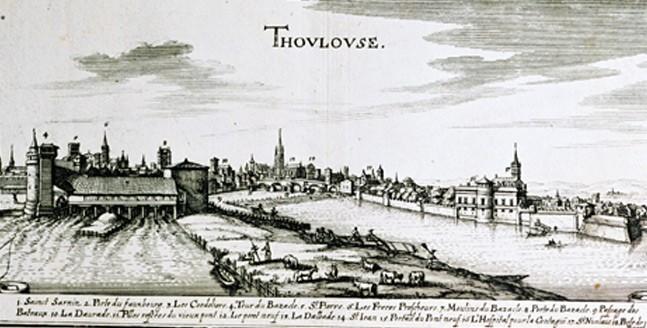
Lieux de mémoire en Midi-Pyrénées
S’étendant des Pyrénées au massif Central et au Limousin, la région Midi-Pyrénées réunit les départements des Hautes-Pyrénées (65), du Gers (32), de la Haute-Garonne (31), du Tarn (81), du Tarn-et-Garonne...

